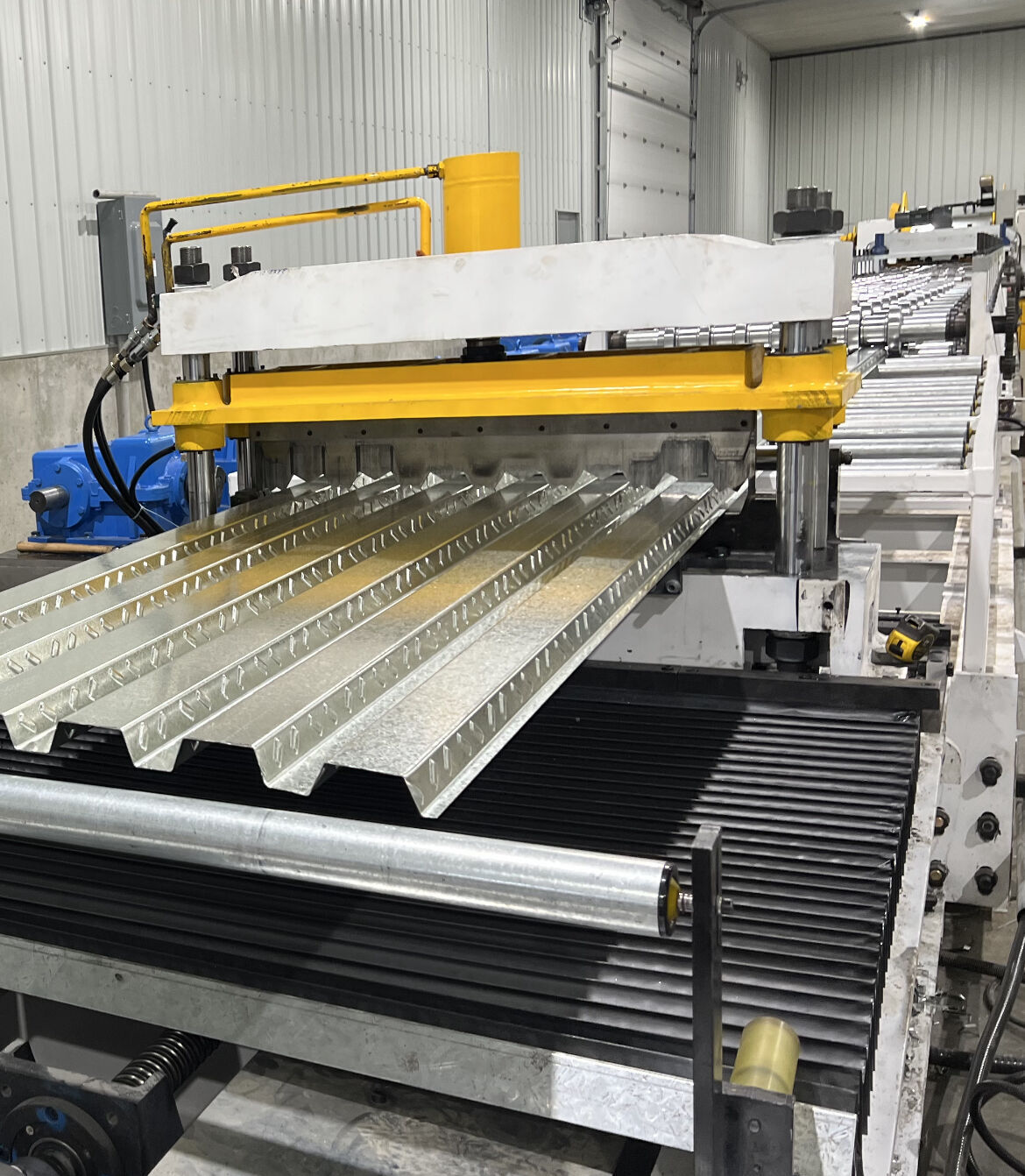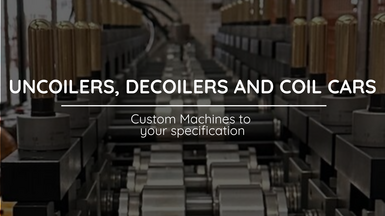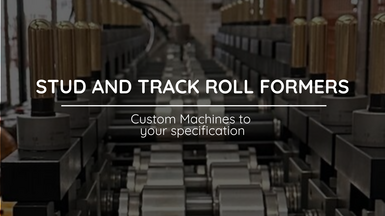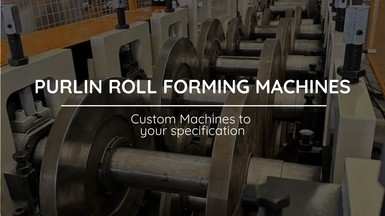
Steel Deck Machines
Here are some key features and functions of steel deck machines:
Posted on Saturday, November 25, 2023
Steel deck machines, also known as steel deck roll forming machines or steel deck forming machines, are industrial machines used in the construction and manufacturing industry to produce steel floor or roof decking panels. These panels are commonly used in the construction of buildings, bridges, and other structures as a structural component to support concrete slabs or roofing materials.
Here are some key features and functions of steel deck machines:
- Roll Forming Process: Steel deck machines use a roll forming process to shape flat steel coils into the desired profile. Roll forming involves passing the steel strip through a series of rollers, each with a specific contour, to gradually shape the material into the final decking profile.
- Material Handling: These machines typically handle galvanized steel coils or sheets of various thicknesses, depending on the design specifications of the decking panels.
- Profile Variety: Steel deck machines can be configured to produce different types of decking profiles, such as ribbed, corrugated, or flat designs, to meet specific construction requirements.
- Cutting and Shearing: After the roll forming process, the machine can cut the formed steel deck panels to the desired lengths. This may involve hydraulic or mechanical shearing mechanisms.
- Control Systems: Modern steel deck machines are equipped with computerized control systems that allow operators to set and adjust parameters like roll spacing, panel length, and production speed.
- High Production Rates: These machines are capable of producing large quantities of steel deck panels in a relatively short amount of time, making them efficient for commercial production.
- Customization: Steel deck machines can be customized to produce panels of different widths, lengths, and thicknesses to meet specific project requirements.
- Quality Control: Quality control features, such as sensors and inspection systems, may be integrated into the machine to ensure that the produced panels meet quality standards and tolerances.
- Safety Features: Safety measures and guards are essential components of steel deck machines to protect operators and prevent accidents during the manufacturing process.
- Maintenance: Regular maintenance is necessary to keep these machines in good working condition, as they are subjected to wear and tear due to the high-speed forming process.
Steel deck panels are widely used in construction for their strength, durability, and fire resistance. They are often used as a structural component in composite floor systems, providing stability and support to concrete slabs in multi-story buildings. Steel deck machines play a crucial role in the efficient production of these essential building materials.
What are the two types of steel decks?
There are two primary types of steel decks used in construction:
- Composite Steel Decking: Composite steel decking, also known as composite metal decking or simply composite decking, consists of a steel deck sheet that is typically corrugated or ribbed and a concrete topping. This type of decking is used in composite floor systems, where the steel deck and the concrete work together to create a strong and efficient structural system. The concrete is poured onto the steel deck, and as it sets, the two materials bond together to form a composite structure. Composite steel decking is commonly used in multi-story buildings for floor construction.
- Non-Composite Steel Decking: Non-composite steel decking, also known as roof deck or form deck, is used primarily in roofing applications rather than as a component of composite floor systems. It consists of steel deck sheets, often with ribs or corrugations, but it does not have the concrete topping seen in composite decking. Non-composite steel decking is typically used to provide a stable base for roofing materials such as single-ply membrane systems, built-up roofing systems, or metal roofing. It helps distribute loads and provides structural support for the roof.
These two types of steel decks serve different purposes in construction. Composite steel decking is primarily used for flooring and provides both structural strength and a working platform during construction, while non-composite steel decking is used for roofing applications to support the roof covering and any potential roof loads. The choice between the two types depends on the specific requirements of the construction project.
Best steel deck machines
Determining the "best" steel deck machine depends on various factors, including your specific production needs, budget, and the quality of the machine. There are several reputable manufacturers and models of steel deck machines available in the market. Here are a few factors to consider when evaluating the best steel deck machine for your needs:
- Production Volume: The machine's capacity should align with your production requirements. Consider the speed and efficiency of the machine in terms of the number of panels it can produce per hour.
- Deck Profile and Customization: Ensure the machine can produce the specific steel deck profile you require for your construction projects. Some machines offer flexibility in terms of profile customization.
- Material Thickness and Width: Make sure the machine can handle the thickness and width of the steel coils or sheets you plan to use. Different projects may require different material specifications.
- Quality and Durability: Look for a machine from a reputable manufacturer known for producing durable and reliable equipment. Quality is crucial to minimize downtime and ensure consistent product quality.
- Control System: Modern machines often come with advanced computerized control systems that allow for easy setup, adjustment, and monitoring of production parameters. User-friendly controls can improve efficiency and reduce errors.
- Safety Features: Safety should be a top priority. Ensure the machine is equipped with safety features and meets relevant safety standards to protect operators during operation.
- Maintenance and Support: Consider the ease of maintenance and the availability of technical support and spare parts from the manufacturer or supplier.
- Cost and Budget: Compare the cost of the machine to your budget constraints. While it's important to consider your budget, it's also essential to balance it with the machine's capabilities and quality.
- Reviews and Recommendations: Research customer reviews and seek recommendations from industry peers who have experience with steel deck machines. Their insights can be valuable in making an informed decision.
- Warranty: Check the warranty offered by the manufacturer. A longer warranty period can provide peace of mind and may indicate the manufacturer's confidence in the machine's reliability.
Steel Floor Deck
Steel floor deck, also known as composite steel floor deck or simply floor deck, is a type of construction material commonly used in building and structural engineering. It serves as a key component in composite floor systems used in the construction of multi-story buildings, warehouses, industrial facilities, and other structures. Steel floor deck provides several important functions and advantages in construction:
- Structural Support: Steel floor deck acts as a structural element that supports the weight of concrete slabs and the loads applied to the floor, such as people, equipment, and furnishings. It helps distribute these loads evenly to the supporting beams and columns.
- Composite Action: Steel floor deck works in conjunction with the concrete poured on top of it to create a composite floor system. The interaction between the steel and concrete results in increased load-carrying capacity and stiffness compared to individual components.
- Fire Resistance: Steel floor deck is often fire-rated and provides fire resistance to the building's floors. This is especially important in commercial and multi-story buildings where fire safety is a concern.
- Durability: Steel floor deck is made from galvanized or coated steel, which offers corrosion resistance and durability. It can withstand harsh environmental conditions, making it suitable for outdoor applications.
- Quick Installation: The installation of steel floor deck is relatively fast and efficient, especially when compared to traditional timber framing. This can lead to shorter construction schedules.
- Savings: By using steel floor deck in composite floor systems, builders can reduce the amount of concrete and structural steel required, leading to cost savings.
- Versatility: Steel floor deck is available in various profiles, including ribbed or corrugated designs. Different profiles offer different load-carrying capacities and span capabilities, allowing for flexibility in design.
- Sound and Vibration Control: Steel floor deck can help control sound transmission and vibrations between floors in multi-story buildings, contributing to occupant comfort.
- Design Flexibility: Engineers and architects have the flexibility to design floor systems with specific load requirements, spans, and fire ratings by selecting the appropriate type and thickness of steel floor deck.
Steel floor deck is typically installed over steel or concrete structural beams and provides a stable platform for workers during construction. Once the concrete slab is poured and cured, the composite floor system becomes an integral part of the building's structure.
The choice of steel floor deck type and specifications depends on the specific needs of the construction project, including the intended use of the building, load requirements, and design preferences.
Steel roof deck
Steel roof deck, also known as metal roof deck or roof decking, is a type of building material used in the construction of roofs for various types of structures, including commercial buildings, industrial facilities, warehouses, and more. Roof deck serves as a foundational component in roofing systems and provides several important functions. Here are some key aspects of steel roof deck:
- Material and Composition: Steel roof deck is typically made from cold-formed steel sheets, similar to steel floor deck. These sheets are often galvanized or coated with protective finishes to enhance their durability and resistance to corrosion.
- Structural Support: Steel roof deck acts as a structural component that supports the weight of the roof covering materials (such as insulation, roofing membrane, or metal roofing) and any imposed loads, including snow, wind, and maintenance personnel. It distributes these loads to the supporting structural framing members, which can include steel or concrete beams or joists.
- Profile and Types: Roof deck comes in various profiles, including ribbed or corrugated designs, with different rib heights, depths, and spacing. The choice of profile depends on factors like load requirements, span, and architectural preferences. Common profiles include Type B, Type F, and Type N.
- Composite Roof Systems: Similar to steel floor deck, steel roof deck can be used in composite roof systems, where it combines with a layer of concrete to create composite action. This enhances the load-carrying capacity and stiffness of the roof structure.
- Quick Installation: Steel roof deck is relatively quick and straightforward to install, making it suitable for projects where speed and efficiency are important. Installation involves attaching the deck sheets to the structural framing members, creating a stable platform for the roof.
- Fire Resistance: Roof deck can be designed to provide fire resistance, helping to meet safety standards and codes. Fire-rated coatings or assemblies may be applied to achieve the desired fire performance.
- Insulation and Roofing Systems: Steel roof deck forms the base upon which roofing insulation and membrane systems are installed. It can accommodate various roofing materials, including single-ply membranes, built-up roofing systems, and metal roofing.
- Sustainability: Many steel roof deck materials are made from recycled steel, contributing to the sustainability of construction projects. The durability of steel roof deck also extends the lifespan of the building.
- Versatility: Steel roof deck is versatile and can be used in a wide range of roofing applications, from flat roofs to sloped roofs.
- Acoustic and Thermal Performance: Some steel roof deck products are designed to improve acoustic and thermal performance in buildings, enhancing occupant comfort.
Steel roof deck plays a critical role in the construction of safe and durable roofs. Its versatility and ease of installation make it a popular choice for architects, engineers, and contractors in various roofing projects. The selection of the appropriate steel roof deck type and specifications depends on factors such as building design, climate, and intended use.
New steel deck machine vs used steel deck machine
Choosing between a new steel deck machine and a used one depends on several factors, including your budget, production requirements, and the condition of the used machine. Here are some considerations for both options:
New Steel Deck Machine:
- Reliability: New machines typically come with warranties and are less likely to have mechanical issues or wear and tear. They offer high reliability and are less likely to experience unexpected breakdowns, leading to lower downtime.
- Latest Technology: New machines often incorporate the latest technology, including advanced control systems, improved safety features, and increased automation, which can enhance productivity and efficiency.
- Customization: Manufacturers may offer options for customizing a new machine to meet your specific production needs, such as choosing the desired profile, width, and other specifications.
- Longevity: New machines are expected to have a longer lifespan compared to used ones, which can provide a better return on investment over time.
- Support and Training: Manufacturers typically provide training and technical support for new machine installations, helping operators learn how to use the equipment effectively.
- Compliance: New machines are more likely to meet the latest safety and environmental regulations, ensuring compliance with industry standards.
Used Steel Deck Machine:
- Cost Savings: Used machines are generally more affordable upfront compared to new ones, making them an attractive option for businesses with budget constraints.
- Immediate Availability: Used machines are readily available, which can be advantageous if you need to start production quickly.
- Depreciation: New machinery tends to depreciate in value rapidly during the first few years. By purchasing a used machine, you may avoid some of this depreciation.
- Known Performance: With a used machine, you can often find information about its historical performance and reliability from the previous owner, helping you assess its condition.
- Quick ROI: If the used machine is in good working order and meets your production needs, you may achieve a quicker return on investment due to the lower initial cost.
However, when considering a used steel deck machine, it's crucial to thoroughly inspect the equipment and, if possible, have a qualified technician evaluate its condition. Pay attention to factors like maintenance records, wear and tear, and the availability of spare parts.
Ultimately, the choice between a new and used steel deck machine should be based on your specific circumstances and priorities. If your budget allows and you prioritize reliability and the latest technology, a new machine may be the better option. If budget constraints are a concern and you can find a well-maintained used machine that meets your requirements, it could be a cost-effective choice. Always consider the long-term implications, including maintenance costs and the expected lifespan of the equipment, when making your decision.
How steel decking is made
Steel decking, also known as metal decking or floor decking, is typically made using a manufacturing process called roll forming. Roll forming is a continuous bending operation that shapes flat metal coils or sheets into the desired profile, which, in the case of steel decking, is typically corrugated or ribbed. Here's an overview of how steel decking is made:
- Material Preparation: The process begins with the preparation of the raw material, which is typically cold-rolled steel coils or sheets. These coils are often made from galvanized steel for corrosion resistance. The steel material is uncoiled and loaded into the roll forming machine.
- Roll Forming Machine: The heart of the manufacturing process is the roll forming machine. This machine consists of a series of rollers, each with a specific contour or shape corresponding to the desired profile of the steel deck. The rollers are arranged in a sequence along the machine.
- Feeding and Guiding: The steel coil is fed into the roll forming machine, and guides or entry rollers ensure that the material is properly aligned and fed consistently through the machine.
- Roll Forming: As the steel material passes through the machine, it undergoes a series of bending operations. Each set of rollers gradually bends the steel into the desired profile, which can include ribs, corrugations, or other features depending on the specific design requirements.
- Cutting: After the steel material has been formed into the desired profile, a cutting mechanism, often located at the end of the roll forming machine, cuts the continuous sheet into individual deck panels at the specified lengths.
- Stacking and Packaging: Once cut, the finished steel deck panels are stacked, bundled, or packaged for shipment to construction sites or distribution centers. They are typically bundled in stacks of uniform size for ease of handling and transport.
- Quality Control: Throughout the manufacturing process, quality control measures are in place to ensure that the steel deck panels meet the required specifications and tolerances. These measures may include visual inspections, dimensional checks, and testing for material properties.
- Additional Processing (Optional): Depending on the specific application and customer requirements, the steel deck panels may undergo additional processes, such as applying protective coatings or fire-resistant materials.
It's worth noting that the design of the roll forming machine and the specific settings used during the roll forming process can be adjusted to produce different types of steel decking profiles with varying dimensions and features.
The roll forming process is efficient and well-suited for high-volume production of steel decking, making it a common method used in the industry. The resulting steel deck panels are used in construction as structural components for floors and roofs, providing support for concrete slabs and roofing materials. Their durability, strength, and ease of installation make them a popular choice in the construction of various types of buildings.
Roll Forming Machines LLC's New Factory
Posted on Sunday, March 23, 2025
We have relocated factories, which will be available for tours very soon.

Uncoiler, Decoiler and Coil Car Roll Forming Machine Accesories from Roll Forming Machines LLC
Posted on Sunday, November 24, 2024
Contact us today with your specifications for a custom Uncoiler, Decoiler or Coil Car at [email protected] or call us at (+1) (407) 859 1119

Stud and Track Roll Forming Machines from Roll Forming Machines LLC
Posted on Saturday, November 23, 2024
Contact us today with your specifications for a custom Stud and Track Machine at [email protected] or call us at (+1) (407) 859 1119

Cee and Zee Purlin Roll Forming Machines from Roll Forming Machines LLC
Posted on Saturday, November 23, 2024
Contact us today with your specifications for a custom Cee and Zee Purlin Machine at [email protected] or call us at (+1) (407) 859 1119